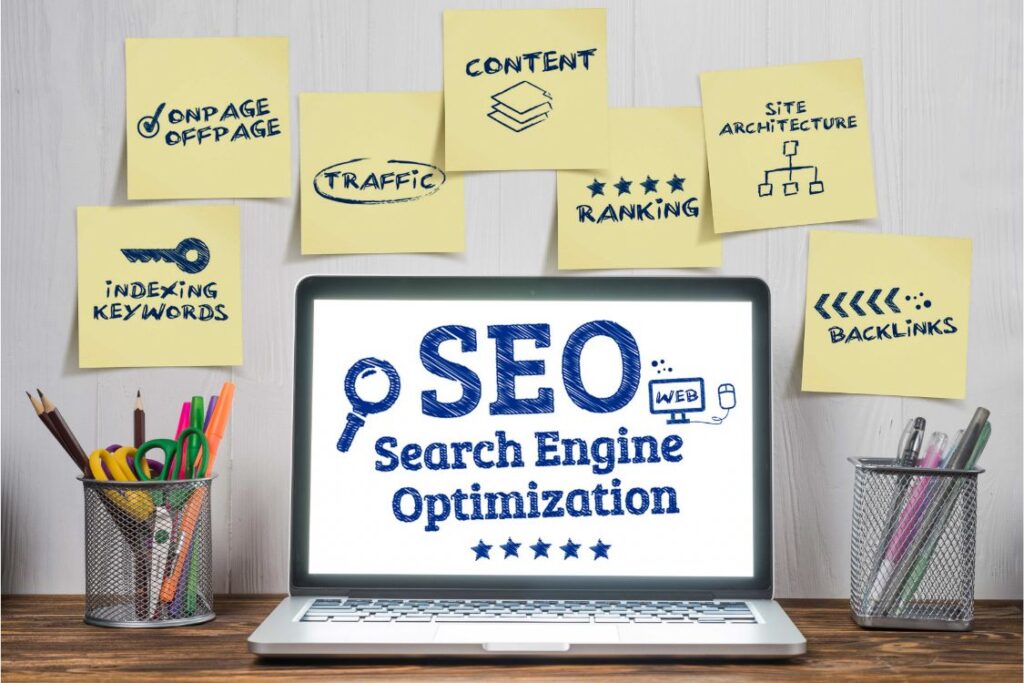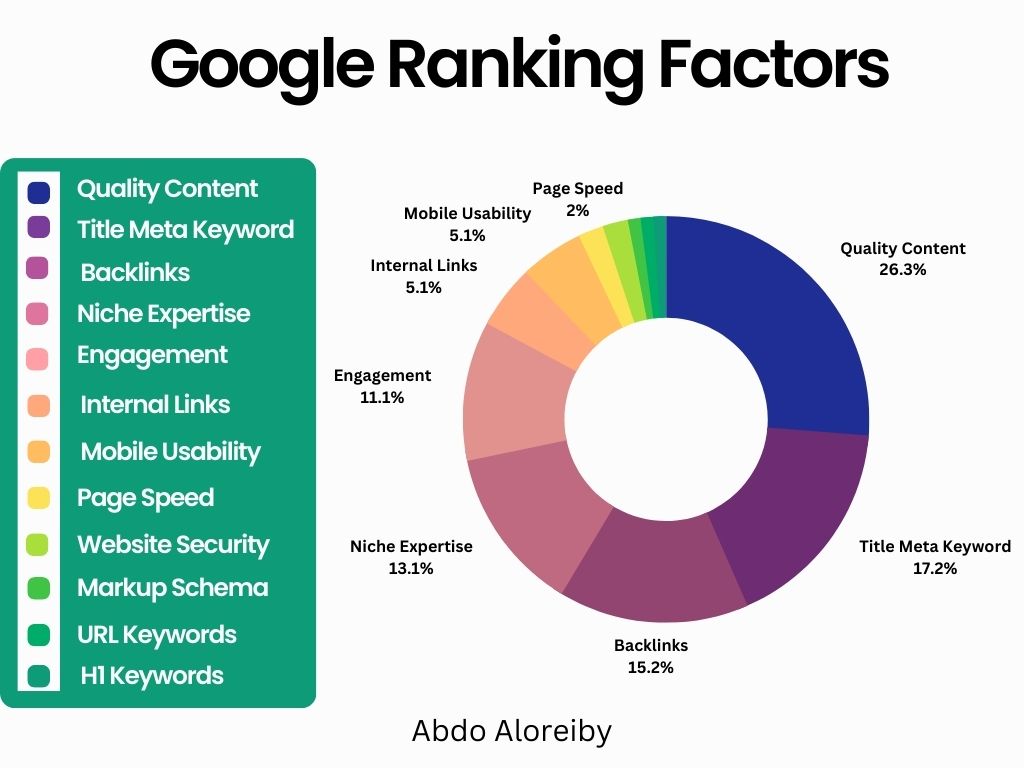
Today, the majority of us use search engines every day. We use it to look for information, solutions, products & services. Google only receives 3.5 billion searches every day. This means that search engine is an essential element in our life. This also gives a lot of opportunities for brands & businesses to reach a huge amount of customers worldwide. This makes SEO a very powerful tool brands & businesses can use in their marketing campaigns.
In this guide, I will explain everything you need to know about SEO. This will help you to rank higher on Google, increase website traffic, and enhance your brand’s reputation.
What is Seo?
SEO stands for Search Engine Optimization. SEO aims to improve your ranking in organic search results page. As a result, the company’s website receives a greater number of visitors, improving their chances of more conversions, which results in more customers and money.
SEO is the activity of increasing both the quality & quantity of your traffic & to rank higher on the results page for specific search terms.
Why Seo is Important?
People are looking for all kinds of items that are both distantly and closely related to your company. These are all chances to interact with these people, provide them with assistance in finding solutions to their issues, and establish yourself as a reliable source. This will lead to:
- More Traffic (Quantity)
When your website is optimized well for search engines it will rank higher in The results. This will increase the number of visitors to your site & increase brand awareness. - More Customer (Quality)
SEO helps you to rank higher for specific search terms that are related to your business. This will attract relevant visitors to your website. Visitors that can easily transformed to customers. - Good Reputation
Ranking higher for Google will increase your business credibility because people trust Google. - Higher ROI
SEO has the highest ROI of all digital marketing channels. Ranking higher means more people that visit your website & buy from you.
SEO is a powerful tool you can use to increase brand awareness, online visibility, leads, sales, or loyal customers.
SEO Vs SEM
Every results page consists of two sections, one for organic results & another for paid results as shown.
SEM or PPC will help to increase your website visibility by placing your website in the paid results section but you will have to pay money. You will do this by Ads.
SEO helps you to rank higher & place your website in the organic results section with no money. You just need to apply some tactics & exert some effort to optimize your website for search engine.

You may think that place your website higher by Ads is more effective & fast than SEO but this is wrong.
People usually ignore Ads & click on organic results. SEO takes more time & effort but it generate more traffic & leads.
How Search Engine Works

Understanding how search engines work will help you see the big picture & find the best practices for ranking higher.
Google always aims to provide searchers with relevant results based on their search terms. To do this Google periodically discovers new content & analyzes it to find its quality.
In general there are 4 stages for doing this:
- Crawling
Google uses crawlers to mine the the web & look for new content. Crawlers are software that are dedicated for discovering new pages. In order for a crawler to find the page, It should include at least link pointing to this page. - Storing
After finding new pages or websites Google download the content to its servers. Google doesn’t show live result for users, Google only show them a copy from these websites. - Indexing
Google then applies hundreds of signals to analyze the content & find its quality & relevancy. These signals could be page title, backlinks, keywords & many other signals. Then give a score for every page based on its content quality. - Ranking
When a searcher writes a query in the search bar, Google shows the best results based on searcher query. Google just goes to the indexed pages to find the most relevant content for searcher’s query.
Types of SEO

When Google & other search engines rank websites, they use hundreds of signals or metrics. We can mainly divide these signals into three categories
1- On-Page SEO
When you try to optimize & improve the quality & relevance of the content on the website.
On-Page includes many factors or signals you can work on. The main ones are:
- Keyword
At first, you should create a list of your targeted keywords. These are the keywords you want to rank for when users type in the search bar. Try to find what search terms your audience can use based on their interests & desires. You can use the Keyword Search tool to help you with this.
Know more about Keyword Research. - Page Title
The title is a very crucial factor in on-page SEO. The page title is the first impression you can make for users. Create a title that define the main topic of the page. Always place the most effective keyword in your title. The title length should be 30-90 characters. - Meta Description
Meta Description is the description snippet that appears under the page title on the results page. The meta description should provide a summary of page content. You also should place some keywords in the meta description. The length of meta should be 60-150 characters. - Page URL
URL should be short & easy to remember. Don’t use numbers in the URL, keep it informative. Place 1 or 2 of your important keywords in the page URL. - Headings
Heading Tags are categorized as H1-H6. Optimize page titles by placing some keywords on them but in a natural & compelling way. H1 should include the most important keywords. Try also to use these headings to divide your content & make it easy for users to navigate & find information. - Images
Images are a great way to improve user engagement & attract their focus.
Save your image file name with a keyword, use dashes instead of spaces. Use Alt Tag to make it easy for search engines to read & find the meaning of the image. Compress large images, image size should be 30-120 kb. - Content Quality
Try to create informative content that users will love & benefit from. You should also use some keywords from your list without stressing on them. Providing a good experience to users is the ultimate goal. - Internal & External Links
External Links are links from your page to pages on other websites. Try to find 1-3 pages relevant to your topic on other sites that have high domain authority & link to them on your page.
Internal Links are links from your page to other pages on your website. Link to other posts in your site make it easy for search engine to crawl the page & find the structure of your website.
2- Off-Page SEO
Off-Page is the activity of creating links on other websites that point to your page, also named backlinks or outbound links. Backlinks are very important for search engines because they act like votes or reviews from others to you. Backlinks effect highly your ranking. But those backlinks must be from credible & high authority websites. Links from suspicious sites can harm your site & penalize you.
How to create backlinks:
- Create Link-Worthy Content
Creating valuable & relevant content is the key to creating backlinks. Create content that will make people want to read, share, and reference in links - Participate in Off-Site Engagement
Build online relationships as people tend to link to people & resources they know. You can do this by leaving comments on blogs & promoting other’s content. Build genuine relationships so that people think of you when they want to link to others. - Promote Your Content on Social Media
Social Media has no direct effect on Google ranking but It affects highly the website traffic.
Sharing content on your social media profiles will generate more referral traffic & likelihood of other to link to you. - Utilize Offline Relationships
You can benefit from your offline relationships like friends & colleagues to promote new online content. You can also reach out to local businesses & agencies.
3- Technical SEO
Technical SEO is about improving website performance on search engines. It’s done on the back end of website. Main technical SEO factors are:
- Page Speed
If the page can’t be loaded within 3 seconds, the user will leave the site. You can improve page speed by coding & compressing images. - Security
The website should include SSL certificate & use HTTPS protocol rather than HTTP. - Mobile Usability
The website should have a full responsive design & work well in different screens like mobiles or tablets not just desktops. Google now care a lot with mobile friendly design. - Website Structure
Website should clear navigational structure that will help users reach any section of the site with few clicks. You can do this by architect proper internal links. - URL Structure
Clear & descriptive URL has many benefits. It help google in better crawling, user to navigate website & easily segment data in your reports. - Canonical Tag
Solving duplicate content issue on the site is vital for SEO. One of the best way to solve this is by using canonical tag. This will inform Google that this page is the original one & other content are copies from the canonical. - Crawlability
You can improve website crawlability by sitemap & robot text file. Sitemap helps the search engine to understand the navigational structure of your site. Robot text file tells Google what pages you want to index & pages to remove from index. - Markup Schema
Markup Schema gives search engine an overview of content on the site & display rich results. It has many types like phone numbers, location & many others.
Know More About Schema Markup.
These were the main SEO types. There are other subtypes like:
- Local SEO
Local SEO aims to rank higher in Google Maps & on the local results page. It’s basically a combination of On-Page & Off-Page SEO. - Image SEO
The activity of ranking higher on Google image search page. It’s also a combination of both On-Page & Technical SEO. - Video SEO
It’s a mix of all the three types of SEO. It helps you to rank higher on YouTube & Google video results.
Google Ranking Factors

As I mentioned before, Google uses hundreds of signals & factors to rank a page. Google also updates its algorithms constantly in order to provide better results for searchers. Google now has nearly 200 ranking factors. Of course each one of them has specific weight & importance. The top Google ranking factors are:
- Consistent High-Quality Content (26%)
- Page Title & Meta Description Keywords (17%)
- Backlinks (15%)
- Niche Expertise (13%)
- Engagement (11%)
- Internal Links (5%)
- Mobile Usability (5%)
- Page Speed (2%)
- Website Security (2%)
- Markup Schema (1%)
- URL Keywords (1%)
- Headings Keywords H1 (1%)
SEO Tools
There are many SEO tools that can help you optimize pages effectively. These tools are segregated into three main categories:
1- Search Engine Tools
They are provided from search engine to help you manage your website effectively. They provide insights on:
- Page Speed
- Crawling Activities
- Technical Compliances
- Keywords Performance
- Critical Issues
- Ranking
Search engine tools come at a cost, but there are also free versions with limited features.
Example: Google Search Console (GSC).
2- Keywords Research Tools
The first step in SEO process is keyword research to define your targeted search terms related to your business & used by your audience. Keyword Research Tool will help you with:
- Keyword Research
- Keyword Analysis
- Competitive Analysis
- Campaign Development
The majority of these tools come at a cost with a very limited free version.
Examples: Wordtracker, SpyFu & Ubersuggest.
3- SEO Management Tools
SEO Management Tools are full-suite SEO tools. They help you entirely manage your SEO & domain efforts. They provide:
- Campaign Metrics
- Link Analysis
- Keyword Research
- Competitor Tracking
- Competitor Analysis
- Historical Data Tracking
These Tools come with a high monthly subscription.
Example: Moz, SemRush & Ahrefs.
Conclusion
SEO is the most powerful channel in digital marketing. It has the highest ROI, and its results last for a very long time & increase business profitability & credibility. SEO helps you attract relevant traffic to your business & gain more leads. But SEO also needs a lot of time, money & effort. So it might be overwhelming at first but SEO is worth any investments you will make. You should also enrich your knowledge with the latest technologies & tactics to help you in your journey.
Thanks for completing the reading & I will be happy to reply to your comment.

